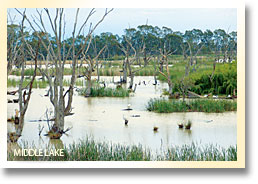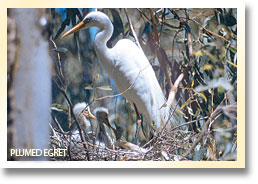
Ibises - Birds of the Murray River Valley
 Ibises, with their distinctive long-curved bill, inhabit the Murray Valley from near Corryong to Lake Alexandrina near the mouth of the river. Both the Australian white ibis and the straw-necked ibis can readily be seen feeding in paddocks, irrigated land and the edges of marshy areas all down the valley. Large flocks, often flying in loose V formation, are also common in the afternoons as the birds return from their feeding grounds to the swamps, lakes and billabongs to roost at night.
Ibises, with their distinctive long-curved bill, inhabit the Murray Valley from near Corryong to Lake Alexandrina near the mouth of the river. Both the Australian white ibis and the straw-necked ibis can readily be seen feeding in paddocks, irrigated land and the edges of marshy areas all down the valley. Large flocks, often flying in loose V formation, are also common in the afternoons as the birds return from their feeding grounds to the swamps, lakes and billabongs to roost at night.
These two ibises, the straw-necked and Australian white ibis, which only occur in the Australasian region, breed in the wetlands along the river from Lake Hume to Lake Alexandrina. Occasionally the smaller glossy ibis, which also occurs in Europe, southern Asia, Africa and North America, also breeds in the Murray Valley, usually following a very wet winter. Many of the breeding colonies are difficult to reach, most being in flooded lakes, swamps and red gum forests far from the nearest roads and tracks.
However around Kerang (Ibis Rookery) there are a number of ibis colonies which are readily accessible to visitors. Some are a little off the main road, and may involve a short walk, but the visit is usually easy, and always fascinating. The extensive colony at Middle Reedy Lake, adjacent to the Murray Valley Highway just north of Kerang, provides spectacular viewing, especially in the late afternoon. At this time flocks are returning to roost at night in dead trees or live trees standing in or near the water. Other nearby colony sites are at Tragowel Swamp and Hird Swamp, breeding being dependent upon sufficient water reaching the wetlands.
In Australia waterbirds, including ibises, have adapted to survive large fluctuations of rainfall and water levels. Ibises usually breed in winter through to late spring and early summer, timing being dependent upon local flooding, although they have been known to nest in late summer after heavy rain. Since they cannot predict subsequent rains and rises in water levels, their nests are frequently flooded or washed away. On such occasions they immediately rebuild their nests and within a few days recommence egg-laying.
The adults take turns at incubation, and in feeding chicks for the first three weeks. Food is brought frequently to the young during the day, when adults may changeover. After three weeks both adults forage for food and the chicks group together in ‘creches’. However each chick is fed only by its parents.
 The variety of nest sites and construction reflects the adaptability of the ibises. Provided the nest site is surrounded by water to minimise attacks by predators on eggs, young and even adults, then almost any semi-solid base will suffice. Along the Murray Valley ibises nest in red gum, willow and other trees, on reeds, rushes and cumbungi, on lignum bushes: and on stumps and logs in the swamps. The nest material is sticks and twigs from whatever local trees are available, but may also be rushes and reeds from the swamp itself. The nest is then lined with leaves of eucalytpus or willows, with grasses or almost any other material (including paper and plastic) which can be found.
The variety of nest sites and construction reflects the adaptability of the ibises. Provided the nest site is surrounded by water to minimise attacks by predators on eggs, young and even adults, then almost any semi-solid base will suffice. Along the Murray Valley ibises nest in red gum, willow and other trees, on reeds, rushes and cumbungi, on lignum bushes: and on stumps and logs in the swamps. The nest material is sticks and twigs from whatever local trees are available, but may also be rushes and reeds from the swamp itself. The nest is then lined with leaves of eucalytpus or willows, with grasses or almost any other material (including paper and plastic) which can be found.
Nests may be built in swamps and along billabongs which after flooding slowly evaporate, or in river red gum forests where the water may slowly drain back to the Murray River system. In all cases there is usually sufficient time for nests to be built and eggs laid (1 week), eggs to be incubated and hatch (3–4weeks) and young to fledge (6–8 weeks) before the water disappears.
However if the wetland becomes dry then the adults will abandon nests, eggs and young. Ibises are also very sensitive to disturbance whilst breeding. Colonies have become deserted after a severe thunderstorm, and birds leave their nests if humans come too close. Even if the adults return to their nests they may find the eggs or young eaten by ravens or other birds.
The Australian white ibis and straw-necked ibis may nest in one colony, or may nest in separate colonies. Where they nest together, the white ibis usually commence up to a month before the straw-necked ibis, and also often continue to breed after the latter have finished. In the Murray Valley the glossy ibis have always bred in a larger colony of either or both of the local species.
As well as their natural feeding areas in and on the margins of shallow wetlands, ibises also feed extensively on irrigated farmland, usually during watering. They feed on small aquatic animals such as fish, frogs, beetles, freshwater crayfish and worms. The long curved bill is used to probe the wet soil and to peck food from the soil surface and shallow water. The straw-necked ibis often feeds in dry paddocks, consuming large numbers of crickets, grasshoppers, locusts and caterpillars.
The adaptable ibises are able to feed and breed all along the Murray River, utilising the different wet and dry habitats which provide food and sites for roosting and nesting.
Photographs by Tom Lowe
Tell your friends you found this at murrayriver.com.au!
Copyright Discover Murray 2024. This site or any portion of this site must not be reproduced, duplicated, copied, sold, resold, or otherwise exploited for any commercial purpose that is not expressly permitted by DISCOVER MURRAY.






 Angove Family Winemakers Art Exhibition featuring Wendy Neal
Angove Family Winemakers Art Exhibition featuring Wendy Neal An Afternoon Of Classical Piano
An Afternoon Of Classical Piano Big Band Christmas Bash 2023
Big Band Christmas Bash 2023 The Royal Edinburgh Military Tattoo 2023 - Arts On Screen
The Royal Edinburgh Military Tattoo 2023 - Arts On Screen